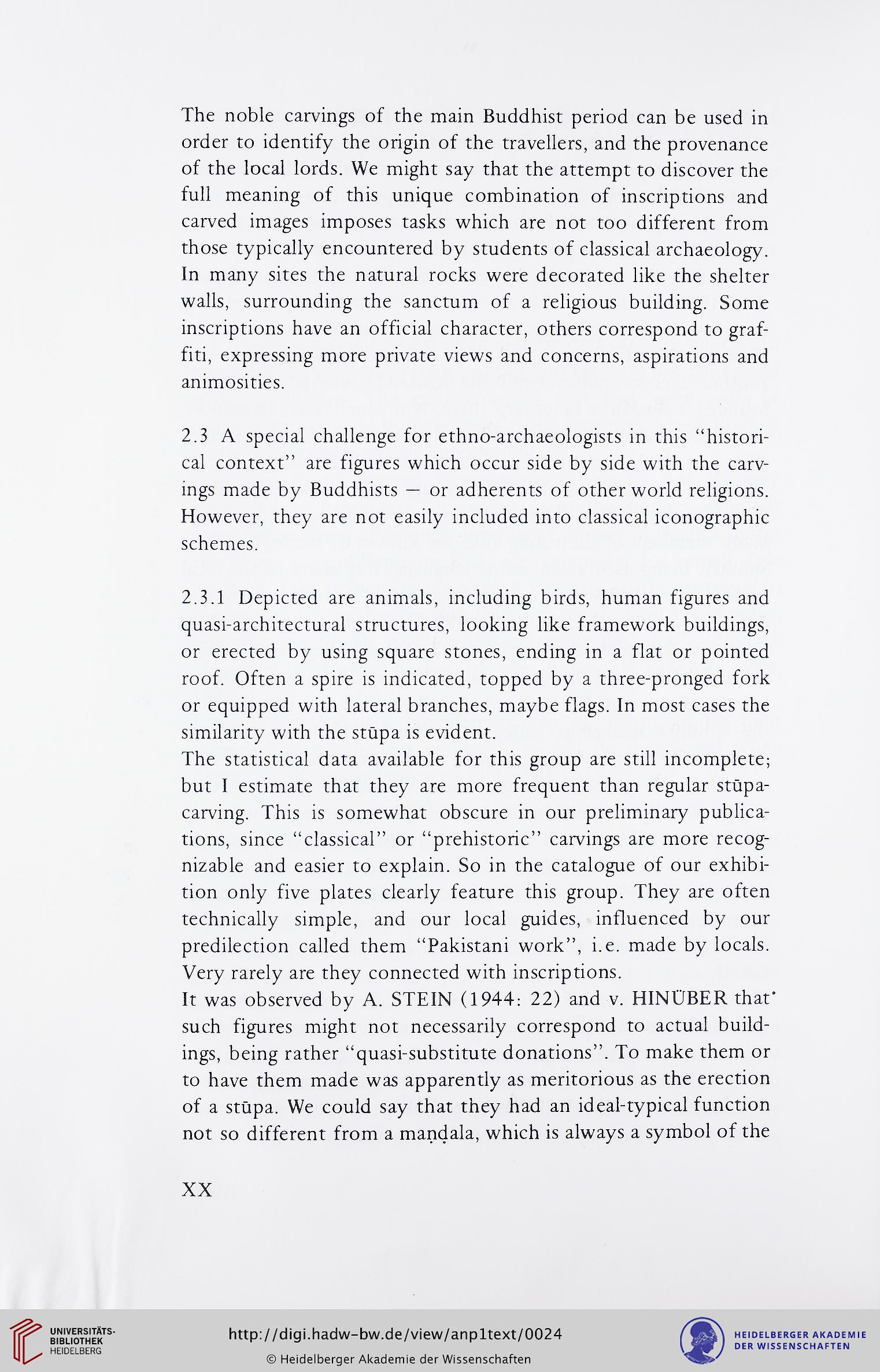The noble carvings of the main Buddhist period can be used in
order to identify the origin of the travellers, and the provenance
of the local lords. We might say that the attempt to discover the
full meaning of this unique combination of inscriptions and
carved images imposes tasks which are not too different from
those typically encountered by students of classical archaeology.
In many sites the natural rocks were decorated like the shelter
walls, surrounding the sanctum of a religious building. Some
inscriptions have an official character, others correspond to graf-
fiti, expressing more private views and concerns, aspirations and
animosities.
2.3 A special challenge for ethno-archaeologists in this "histori-
cal context" are figures which occur side by side with the carv-
ings made by Buddhists — or adherents of other world religions.
However, they are not easily included into classical iconographic
schemes.
2.3.1 Depicted are animals, including birds, human figures and
quasi-architectural structures, looking like framework buildings,
or erected by using square stones, ending in a flat or pointed
roof. Often a spire is indicated, topped by a three-pronged fork
or equipped with lateral branches, maybe flags. In most cases the
similarity with the stupa is evident.
The statistical data available for this group are still incomplete;
but I estimate that they are more frequent than regular stupa-
carving. This is somewhat obscure in our preliminary publica-
tions, since "classical" or "prehistoric" carvings are more recog-
nizable and easier to explain. So in the catalogue of our exhibi-
tion only five plates clearly feature this group. They are often
technically simple, and our local guides, influenced by our
predilection called them "Pakistani work", i.e. made by locals.
Very rarely are they connected with inscriptions.
It was observed by A. STEIN (1944: 22) and v. HINUBER that*
such figures might not necessarily correspond to actual build-
ings, being rather "quasi-substitute donations". To make them or
to have them made was apparently as meritorious as the erection
of a stupa. We could say that they had an ideal-typical function
not so different from a mandala, which is always a symbol of the
XX
order to identify the origin of the travellers, and the provenance
of the local lords. We might say that the attempt to discover the
full meaning of this unique combination of inscriptions and
carved images imposes tasks which are not too different from
those typically encountered by students of classical archaeology.
In many sites the natural rocks were decorated like the shelter
walls, surrounding the sanctum of a religious building. Some
inscriptions have an official character, others correspond to graf-
fiti, expressing more private views and concerns, aspirations and
animosities.
2.3 A special challenge for ethno-archaeologists in this "histori-
cal context" are figures which occur side by side with the carv-
ings made by Buddhists — or adherents of other world religions.
However, they are not easily included into classical iconographic
schemes.
2.3.1 Depicted are animals, including birds, human figures and
quasi-architectural structures, looking like framework buildings,
or erected by using square stones, ending in a flat or pointed
roof. Often a spire is indicated, topped by a three-pronged fork
or equipped with lateral branches, maybe flags. In most cases the
similarity with the stupa is evident.
The statistical data available for this group are still incomplete;
but I estimate that they are more frequent than regular stupa-
carving. This is somewhat obscure in our preliminary publica-
tions, since "classical" or "prehistoric" carvings are more recog-
nizable and easier to explain. So in the catalogue of our exhibi-
tion only five plates clearly feature this group. They are often
technically simple, and our local guides, influenced by our
predilection called them "Pakistani work", i.e. made by locals.
Very rarely are they connected with inscriptions.
It was observed by A. STEIN (1944: 22) and v. HINUBER that*
such figures might not necessarily correspond to actual build-
ings, being rather "quasi-substitute donations". To make them or
to have them made was apparently as meritorious as the erection
of a stupa. We could say that they had an ideal-typical function
not so different from a mandala, which is always a symbol of the
XX




